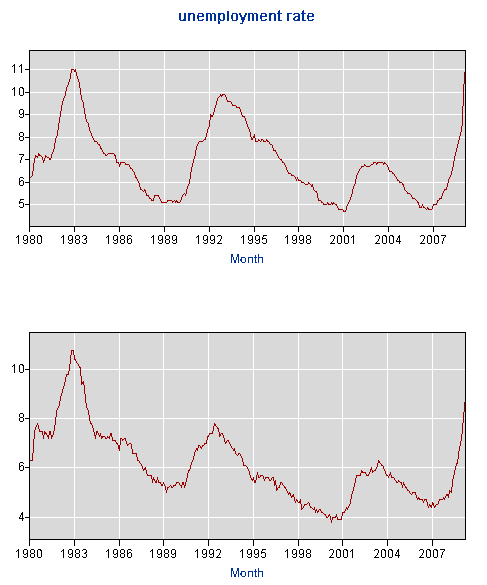Take a look at these two graphs. The first is the unemployment rate for California since 1980. The second is the national unemployment rate for the same period.

Do you notice anything peculiar about the relationship to unemployment in California versus unemployment in the U.S. as a whole? If you look closely, you can see that sometime in the early 1990’s California stopped mirroring the national rate. It continued to track the ups and downs pretty much but with at a higher rate. From about 1991 on, California’s unemployment rate has been between 1% and 2% higher than the rest of the country’s.
Why did that happen? Basically, California had a big chunk of its economy vaporized in the early ’90’s and never recovered. Recall that the Berlin Wall came down about that time and the “peace” dividend was realized. The defense industry was permanently downsized and California went through a tough recession. It never was quite able to replace the employment that it lost and these were by and large high paying white and blue-collar jobs.
Why does this matter? For all the pixels that have been wasted decrying the growth of the financial services sector the simple fact remains that the industry provided a lot of employment and not just to $10 million a year traders. As that industry and perhaps the real estate industry (I include home builders and construction workers as well as service employees in that term) see a permanent reduction in size we might well see the unemployment rate settle higher than what we have come to define as a full employment rate. Instead of 4.5% or 5% unemployment in a good economy, 6.5% or even 7% might reflect the reality of the economy that emerges from the recession.
The California lesson is an apt one. You don’t wipe out a big part of an industry without paying a price.
- Bulenox: Get 45% to 91% OFF ... Use Discount Code: UNO
- Risk Our Money Not Yours | Get 50% to 90% OFF ... Use Discount Code: MMBVBKSM
Disclaimer: This page contains affiliate links. If you choose to make a purchase after clicking a link, we may receive a commission at no additional cost to you. Thank you for your support!



Leave a Reply